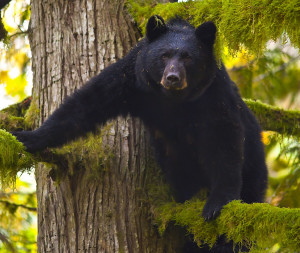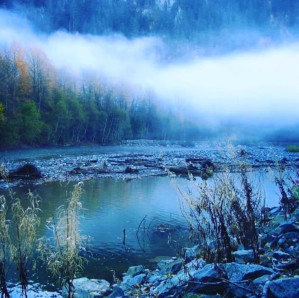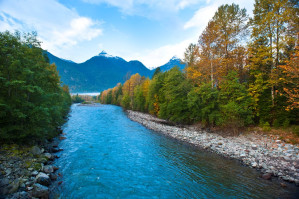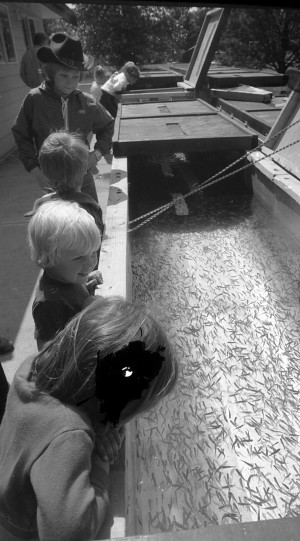Conservation
"One of the most important and progressive education centres in existence, and its diverse and unique curriculum is the envy of many."
Rob Bell-Irving, Community Advisor, DFO


Sp’ákw’us, the bald eagle

Bird of the Year 2024



Overview
Cheakamus Centre values responsible stewardship of this remarkable 165 ha ecological preserve, which includes the Dave Marshall Salmon Reserve. Together with conservation partners, Cheakamus Centre strives to protect the diverse natural communities that benefit a variety of wildlife species. Responsible stewardship requires thoughtful management. The maintenance, restoration, and enhancement of habitat and achieving a balance between interaction and protection on the site remain a key priority for Cheakamus Centre.
Cheakamus Centre, Fisheries and Oceans Canada (DFO) and various partners such as Bridge Coastal Restoration (BC Hydro), Squamish Watershed Society and Squamish Nation have been working together since 1981 to restore historic salmon habitat throughout the property. These projects are part of a large, multi-phased initiative to restore the side channel habitats of the Cheakamus River which provide secure refuges for salmon from the winter floods common on the Cheakamus River. These restored habitats support thousands of spawning chum, coho, pink, chinook, steelhead and sockeye salmon each season. This biologically rich portion of the watershed called "Paradise Valley" provides critically important habitat for overwintering populations of bald eagles which depend on the salmon for a food supply. As a result of these successful partnerships, Cheakamus Centre now has the most restored side-channels in the Squamish Watershed.
Yellow-rumped warbler, crowned Bird of the Year 2024
The bird booth at our 2024 Open House was a busy voting station as visitors were challenged to elect the Cheakamus Centre's Bird of the Year. It was a close race for all the four selected species: Pacific wren, pileated woodpecker, yellow-rumped warbler, and great blue heron. At the end of the day, with 114 votes cast, the yellow-rumped warbler managed to squeak ahead and claim its tiny Bird of the Year crown!
What can be said about this wonderful species other than it's about time it earned its place in the ranks of our birds of the year! April and May are peak times for this colourful migrant at the Cheakamus Centre when flocks fill the woods with the rising and falling songs of the yellow-rumped warbler. The best places to spot them are in the low trees along the canoe pond and other pond and stream areas. In the fall, look for them in berry bushes, as they switch much of their diet from insects to berries. This highly adaptable species travels farther north than any other warbler and is known as a long-living species, occasionally living well-beyond ten years. For these reasons and more, we are proud to name the tenacious yellow-rumped warbler the Cheakamus Centre’s Bird of the Year for 2024.
*Thank you to Brooksbank Teacher Mark Thomson for sharing this story and image.
Dave Marshall Salmon Reserve
The great numbers of salmon presently spawning on the Cheakamus Centre property are the result of over three decades of combined efforts to rebuild and restore salmon habitat. Dave Marshall was a respected Fisheries Biologist who was responsible for many of the salmon spawning channels that exist today at Cheakamus Centre.
The concept of the groundwater spawning channel was pioneered by Dave Marshall and engineer Rheal Finnigan of the federal Salmonid Enhancement Program. The first groundwater salmon spawning channel, the Upper Paradise channel, was created along the Cheakamus River in 1982. Since that time further salmon spawning and rearing habitats have been developed in the Paradise Valley, with many of them located at Cheakamus Centre.
The Dave Marshall Salmon Reserve is dedicated to Dave who passed away in 1999. His passion for the salmon resource inspired many who knew and worked with him. His legacy for future generations will be the sounds of salmon splashing in the night, the soft rush of an eagle taking flight and the dance of the dipper feeding on salmon eggs.
The salmon reserve features restored habitats that fall into three broad categories. Each of these types of habitat is used somewhat differently by the various species of salmon.
Kisutch and Upper Paradise channels are examples of groundwater spawning channels. They are constructed by digging old river channels deeper so that they intercept clean groundwater flowing just below the surface of the river floodplain. Winter or summer, these habitats have a steady flow of clean groundwater. Spawning Chum salmon use these habitats extensively, as do spawning coho salmon. They also provide good summer habitat for young coho salmon fry.
The various pond complexes at Cheakamus Centre provide good habitat for young coho salmon during their first summer of life. Ponds are considered critical habitat in the winter for young coho salmon which seek out their deep quiet waters as a refuge from the winter storms in the Cheakamus River.
River fed channels are connected directly to the Cheakamus River by means of a pipeline which regulates the flow of water to these habitats. The water in these channels can be coloured by glacial silt in the summer and eroded soils during the heavy rain storms of winter. The more variable flows and temperatures found in these habitats are preferred by pink salmon and coho salmon and lightly used by chum salmon. The Moody and Farpoint channels are examples of this type of habitat.
These diverse habitats support over 40,000 chum, coho, pink, chinook and steelhead salmon which return to spawn at Cheakamus Centre from August to February annually.
By early winter the eagles increase their presence, arriving for their winter feast of the spawned out salmon within the reserve which is further protected by Nature Conservancy of Canada environmental covenant.
This intricate cycle of life and death continues in part because of the many dedicated people that have ensured salmon will always have a place at Cheakamus Centre. It is Dave's legacy to the children of today, that they respect the environment, honour the salmon and pursue with passion their own life's calling.
A Valley Called “Paradise”
By far the largest spawning chum salmon aggregation is located in a 4-kilometer section of the lower Cheakamus River. This area is known locally as the “Paradise Valley”. In some years more than 150,000 chum salmon can spawn in this short reach of the river. Various groundwater side channels of the lower river, known by locals as Tenderfoot, BC Rail, Lower and Upper Paradise and Moody’s have been expanded and enhanced for chum salmon spawning. Dave Marshall DFO initiated the first salmon restoration project back in 1981 with Cheakamus Centre carrying the charge. For the next 35 years our property has remained the ecologically focused salmon and eagle refuge it is today. Read more about this story.

